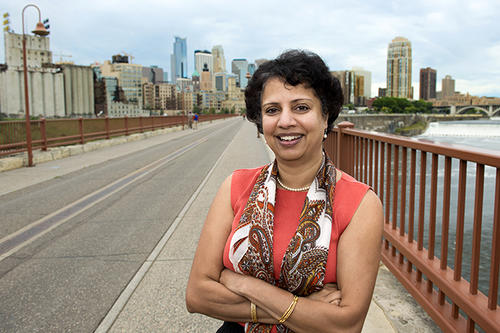
If ever a project could be held up as a picture-perfect example of the word “interdisciplinary,” this is it.
The U of M’s Anu Ramaswami is directing a vast new network of academics, scientists, industry leaders, and policy partners studying ways to make cities more environmentally sustainable and more tangibly “livable” in ways that advance human health and well-being. The project, funded through a $12 million award from the National Science Foundation, is called “Integrated Urban Infrastructure Solutions for Environmentally Sustainable, Healthy, and Livable Cities.”
A lofty title, to be sure, but the network is definitely deep and diverse. In addition to the industry and policy partners, the project includes 25 faculty members from nine universities (including many from the U of M), plus more than 40 graduate students conducting research in cross-university interdisciplinary teams.
And for Ramaswami, a professor of science, technology, and environmental policy at the Humphrey School of Public Affairs and at the Department of Bioproducts and Biosystems Engineering, as well as a resident fellow at the Institute on the Environment, her work over the next four years couldn’t be more exciting and enticing.
“We’re looking at infrastructure in terms of high-level design ... whether it should be local or a mix of local and large, at new game-changing technologies, and also at human behavior and policy,” she says. “So we integrate all of those things, and that’s why it’s called integrated infrastructure solutions.”
The project will study a new movement toward “distributed,” or more local, infrastructure in cities—as an alternative to very large infrastructure systems like massive power grids and complex systems for piping in water from distant sources and food from faraway locales. Examples of local systems include urban farms, local solar generation, district energy systems, and bike-sharing programs. The team will study interactions involving urban water, energy, transportation, green infrastructure, and food systems, all together.
“We’re not saying that more distributed is automatically better in all these sectors or in all cities,” Ramaswami says. It may be better for certain city types, and the key is to find the sustainable and healthy infrastructure roadmap for each city.
To that end, researchers will collaborate with cities across the United States and in India to develop case studies on various components of sustainability, health, and livability.
One of those is the happiness of city residents. Ramaswami points to the work of Humphrey School associate professor Yingling Fan, who is pioneering a new way of measuring the emotional well-being of urbanites “in the moment,” based on a smartphone app where people would record their emotions as they go about their daily activities.
The phone tracks where they’re located, so the researchers can start to make correlations on factors like the physical environment, air pollution, and how hot or cold it is outside, she says. “Over time, you can start understanding these dynamic interactions that people have with infrastructure and the urban environment.”
For Ramaswami, the work ahead is not only dynamic and exciting but also imperative. It’s estimated that by 2050, almost 3 billion more people—two-thirds of the world’s population—will live in urban areas, further stressing our water, land, and energy resources and threatening livability, not to mention human health.
“The fact that we have business, industry, and policy partners in our network and our research is being done with case studies in real cities, the potential … for real-world impact is really big,” she says. “I see the potential for thoughtful and high-impact decision-making and action in cities and communities, and that’s what drives me.”
- Categories:
- Science and Technology





